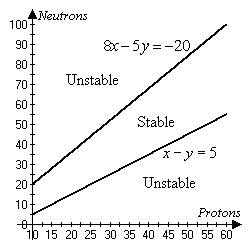Add or subtract. +
+ 
A. 
B. 
C. 
D. 
Answer: D
You might also like to view...
Provide an appropriate response.For 2x2 + 3y2 + 2z2 = 16, evaluate  when x = 1, y = 2, z = -1.
when x = 1, y = 2, z = -1.
What will be an ideal response?
Find the sum or difference and reduce to lowest terms. +
+  +
+ 
A. 
B. 15
C. 
D. 
Solve the problem.Atomic nuclei consist of protons and neutrons. The number of protons and neutrons in a particular nucleus must fall into a well-defined range of values in order for the nucleus to be stable, else it will be unstable and will disintegrate by radioactive decay. The figure below shows this so-called "region of stability" for nuclei having proton numbers between 10 and 60. Using the figure, comment on the stability of a nucleus that contains 35 protons and 50 neutrons.
A. The nucleus falls within the region of stability and therefore will be radioactive. B. The nucleus falls outside the region of stability and therefore will be radioactive. C. The nucleus falls outside the region of stability and therefore will be nonradioactive. D. The nucleus falls within the region of stability and therefore will be nonradioactive.
Solve the problem.Find an equation for the least squares line representing weight, in pounds, as a function of height, in inches, of men. Then, predict the height of a man who is 145 pounds to the nearest tenth of an inch. The following data are the (height, weight) pairs for 8 men: (66, 150), (68, 160), (69, 166), (70, 175), (71, 181), (72, 191), (73, 198), (74, 206).
A. 63.2 inches B. 68.2 inches C. 65.7 inches D. 64.6 inches